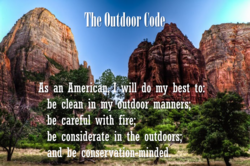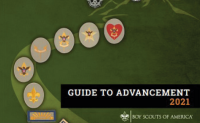
Most troops start off their meetings with the Pledge of Allegiance followed by a usually speedy recitation of the Scout Oath and Scout Law:
Okay, so Frankfurter patrol, Scout Oath!
Scout Sign! A Scout is Trustworthy Loyal…
NO! Scout Oath!
Oh…Â OnmyhonorIwilldomybest…
Yeah, we’ve all been there. But does your troop follow these with the Outdoor Code?
I’m always impressed when I visit a troop that includes saying the Outdoor Code as part of its opening ceremony. It shows that the Scouts are at least familiar with the rules of etiquette of the great outdoors, which is where Scouting really happens.
With the changes coming next year, knowing the Outdoor Code from memory is going to be one of the requirements for the new Scout rank (and yes, Scout goes from the joining requirement to an actual rank). Tenderfoot candidates need to explain what it means and how they’ve practiced it on a campout. The Second Class and First Class requirements include Leave No Trace awareness and practice.
I often have had the chance to ask Scouts about the Outdoor Code during boards of review. I don’t re-test them on it but I ask questions to discover their familiarity with it. I’m usually pleased to find that while many Scouts can’t recite it verbatim, most are familiar with the concepts and can tell what it means. Knowing the words and rattling them off on command is just the beginning. One true test of an outdoorsman is to know and naturally practice the ethics behind the Outdoor Code, Leave No Trace, Tread Lightly and other such codifications.
Not only is it a good time to reintroduce the Outdoor Code if your Scouts haven’t been making it a part of their meetings, but for the Scouts to know it well, and what it signifies, so when the new guys arrive next spring it’ll be second nature.
This post first appeared on Bobwhite Blather.



